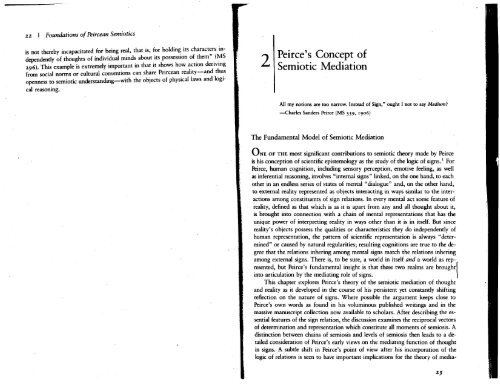SIGNS IN SOCIETY - STIBA Malang
SIGNS IN SOCIETY - STIBA Malang
SIGNS IN SOCIETY - STIBA Malang
Create successful ePaper yourself
Turn your PDF publications into a flip-book with our unique Google optimized e-Paper software.
zz I Foundations of Peircean Semiotics<br />
is not thereby incapacitated for being real, that is, for holding its characters independently<br />
of thoughts of individual minds about its possession of them" (MS<br />
296). This example is extremely important in that it shows how action deriving<br />
from social norms or cultural conventions can share Peircean reality—and thus<br />
openness to semiotic understanding—with the objects of physical laws and logical<br />
reasoning.<br />
2<br />
Peirce's Concept of<br />
Semiotic Mediation<br />
All my notions are too narrow. Instead of Sign," ought I not to say Medium}<br />
—Charles Sanders Peirce (MS 339, 1906)<br />
The Fundamental Model of Semiotic Mediation<br />
ONE OF THE most significant contributions to semiotic theory made by Peirce<br />
is his conception of scientific epistemology as the study of the logic of signs. 1<br />
For<br />
Peirce, human cognition, including sensory perception, emotive feeling, as well<br />
as inferential reasoning, involves "internal signs" linked, on the one hand, to each<br />
other in an endless series of states of mental "dialogue" and, on the other hand,<br />
to external reality represented as objects interacting in ways similar to the interactions<br />
among constituents of sign relations. In every mental act some feature of<br />
reality, defined as that which is as it is apart from any and all thought about it,<br />
is brought into connection with a chain of mental representations that has the<br />
unique power of interpreting reality in ways other than it is in itself. But since<br />
reality's objects possess the qualities or characteristics they do independently of<br />
human representation, the pattern of scientific representation is always "determined"<br />
or caused by natural regularities; resulting cognitions are true to the degree<br />
that the relations inhering among mental signs match the relations inhering<br />
among external signs. There is, to be sure, a world in itself and a world as represented,<br />
but Peirce's fundamental insight is that these two realms are brought<br />
into articulation by the mediating role of signs.<br />
This chapter explores Peirce's theory of the semiotic mediation of thought<br />
and reality as it developed in the course of his persistent yet constantly shifting<br />
reflection on the nature of signs. Where possible the argument keeps close to<br />
Peirce's own words as found in his voluminous published writings and in the<br />
massive manuscript collection now available to scholars. After describing the essential<br />
features of the sign relation, the discussion examines the reciprocal vectors<br />
of determination and representation which constitute all moments of semiosis. A<br />
distinction between chains of semiosis and levels of semiosis then leads to a detailed<br />
consideration of Peirce's early views on the mediating function of thought<br />
in signs. A subtle shift in Peirce's point of view after his incorporation of the<br />
logic of relations is seen to have important implications for the theory of media-<br />
2-3










